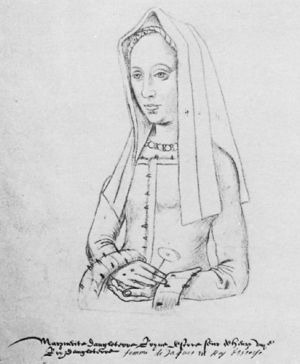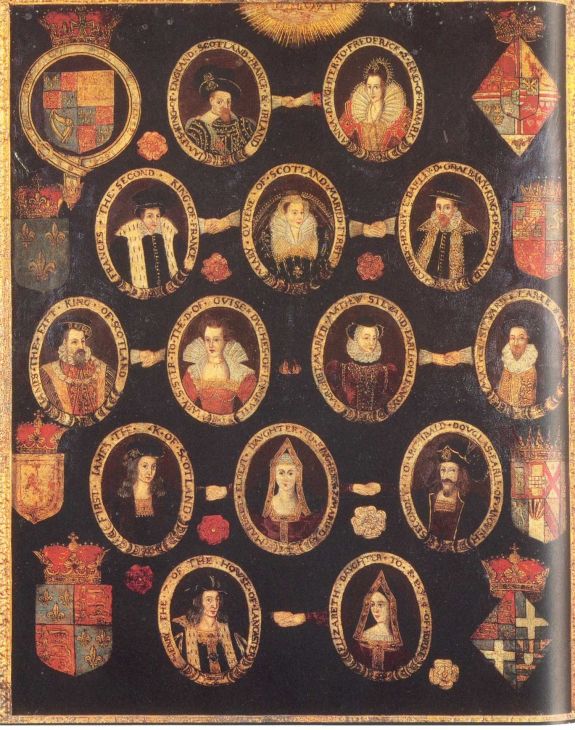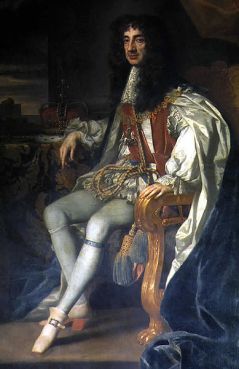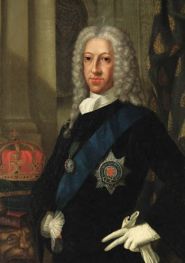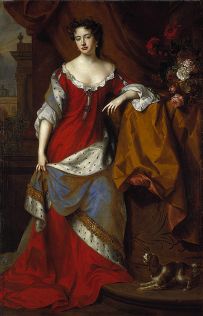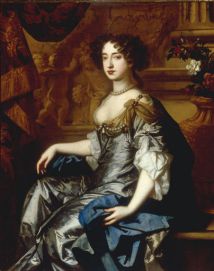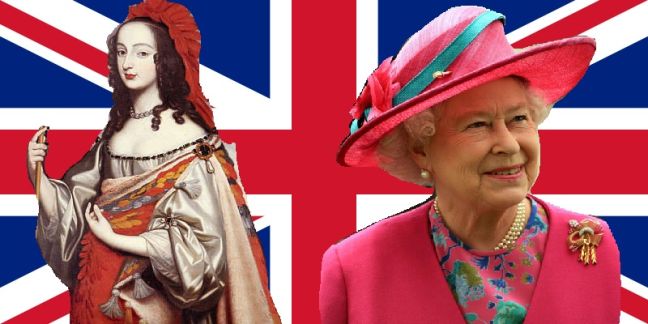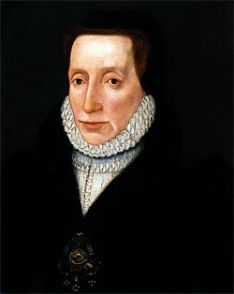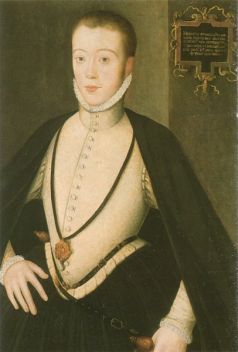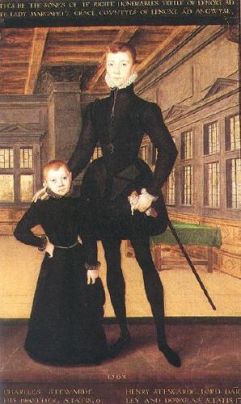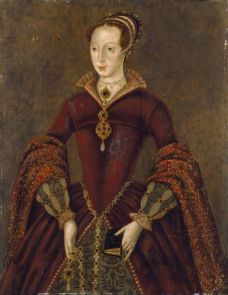Margaret and Mary's Descendants
Jump to navigation
Jump to search
| Descendants of the Tudor sisters |
| Margaret Tudor and James IV of Scotland Stuart |
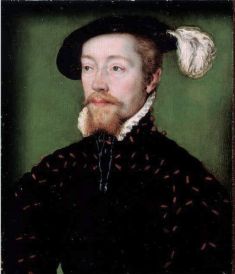 James V King of Scotland (10 April 1512 - 14 December 1542) Third and only surviving son of Margaret Tudor and her 1st husband, King James IV of Scotland. House of Stuart Marriages: 1st: Madeleine of Valois, no issue. 2nd: Mary of Guise, Madame de Longueville James' father was killed when he was only seventeen months old. He was crowned at Stirling Castle on 21 September 1513. It was his mother, Margaret, who would become Regent in his stead from 1513-1514 until her second marriage. Following her were Robert Maxwell, John Stewart of Albany, and his stepfather Sir Archibald Douglas of Angus. During his reign there was constant friction between him and King Henry VIII. This was settled somewhat in May 1534 when a treaty was signed. It was Henry who suggested the marriage of James to his daughter, Mary, but James was inclined to take a French bride, Madeleine of Valois. James and his 2nd wife Mary had only one surviving child who would become Mary, Queen of Scots. James also had about nine illegitimate children by different mistresses. Some of his sons were enobled while others married into aristocracy. Some of his descendants by those women include the Dukes of Argyll, Earl of Moray, the Verney Baron Willoughby's of Brooke and more. | 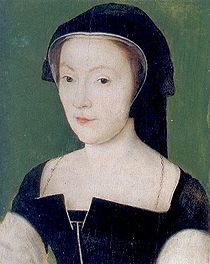 Mary of Guise Queen consort of Scots Madame of Longueville (22 November 1515 - 11 June 1560) She was the eldest child of Claude of Guise and Antoinette of Bourbon. Marriages: 1st: Louis II of Orleans, Duke of Longueville by whom she had two sons. Mary was one of the possible suitors for Henry VIII after the death of Jane Seymour. Even after the announcement of her betrothal to James V, Henry persisted. James and Mary were married by proxy in Paris and again at St. Andrews upon her arrival in Scotland. After the death of her husband, James V of Scots, their daughter, Mary of Scots became queen regent at only six days old. The regency was taken up by her cousin who was next in line after the baby queen to the Scottish throne, James Hamilton, 2nd Earl of Arran from 1542-1554. It was Mary of Guise who then took over from 12 April 1554 until her death on 11 June 1560. During her regency Mary consulted on a constant basis with her brothers in France and even gave french men high positions at court. She even used French troops to reinforce the Scottish army. |
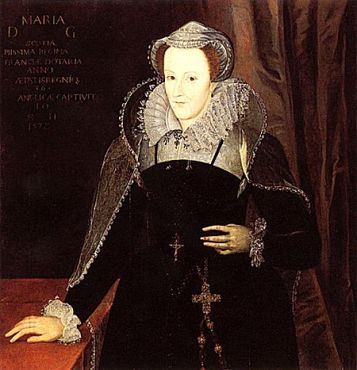 Mary I Mary I Queen of Scotland Queen consort of France (8 December 1542 – 8 February 1587) Marriages: 1st: Francis II, King of France on 24 April 1558 at Notre Dame Cathedral, Paris, France. No issue. 2nd: Henry Stuart, Lord Darnley on 29 July 1565 at Holyrood Palace Chapel, Edinburgh, Midlothian, Scotland. Had issue. *Henry was her half first cousin. 3rd: James Hepburn, 4th Earl of Bothwell on 15 May 1567 at Holyrood Abbey, Edinburgh, Midlothian, Scotland. Issue died. Mary became queen at the age of six days old after the death of her father on 14 December 1542. Her mother, Mary of Guise, while Mary was still a child took her place as regent after it had been held by Mary's cousin, the Earl of Arran until Mary was of age. Mary of Guise chose to surround herself with her fellow French nobles which made England weary. On 7 August 1548 Mary went to France, growing up as a Roman Catholic there in the King of France's household. Mary married three times. As a result of her marriage to the Dauphin Francis (later King Francis II of France), Mary Stuart, Queen of Scotland was styled as Queen Consort Mary of France on 6 July 1559 after the death of Francis' father, Henry II. The couple had no children. 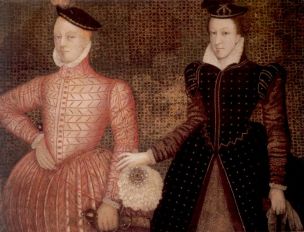 On 19 August 1561 she returned to Scotland to rule in person. In 1565 she married her first half cousin, Henry Stuart, Lord Darnley. Darnley, like Mary, was the granddaughter of Margaret Tudor giving them both a claim to the throne of England. Therefore their children would inherit both parents' claims, and thus, be next in line for the English throne after the descendants of Mary Tudor, according to King Henry VIII's will. The union infuriated Elizabeth, who felt she should have been asked permission, as Darnley was an English subject. The couple had one child, James, who after the death of his cousin Queen Elizabeth I and despite the will of Henry, would become the next King of England.(Explanation of the failure of the Succession of Mary Tudor is discussed at the bottom of the page). On 19 August 1561 she returned to Scotland to rule in person. In 1565 she married her first half cousin, Henry Stuart, Lord Darnley. Darnley, like Mary, was the granddaughter of Margaret Tudor giving them both a claim to the throne of England. Therefore their children would inherit both parents' claims, and thus, be next in line for the English throne after the descendants of Mary Tudor, according to King Henry VIII's will. The union infuriated Elizabeth, who felt she should have been asked permission, as Darnley was an English subject. The couple had one child, James, who after the death of his cousin Queen Elizabeth I and despite the will of Henry, would become the next King of England.(Explanation of the failure of the Succession of Mary Tudor is discussed at the bottom of the page).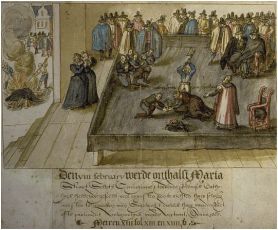 On 23 April 1567 at Almond Bridge, Scotland, she was seized by the Earl of Bothwell, and held prisoner in Dunbar Castle. When Mary returned to Edinburgh in May of that year she married her third and last husband, James Hepburn, who was suspected of assassinating Mary's second husband, Lord Darnley. The match was not approved of by the nobility and they turned against them which resulted in the imprisonment of Mary at Loch Leven Castle. It was there, sometime in May, that she gave birth to twin stillborn boys fathered by Bothwell. On 23 April 1567 at Almond Bridge, Scotland, she was seized by the Earl of Bothwell, and held prisoner in Dunbar Castle. When Mary returned to Edinburgh in May of that year she married her third and last husband, James Hepburn, who was suspected of assassinating Mary's second husband, Lord Darnley. The match was not approved of by the nobility and they turned against them which resulted in the imprisonment of Mary at Loch Leven Castle. It was there, sometime in May, that she gave birth to twin stillborn boys fathered by Bothwell. On 24 July 1567, Mary abdicated as Queen of Scotland in favour of her son James (the future James I of England). In May 1568 she escaped to England, where she was heir to the thone. Fearing pro-Catholic plots to make Mary Queen of England, her cousin Elizabeth I imprisoned her and eventually had her executed. Mary's tomb is in Westminster Abbey, London, England. |
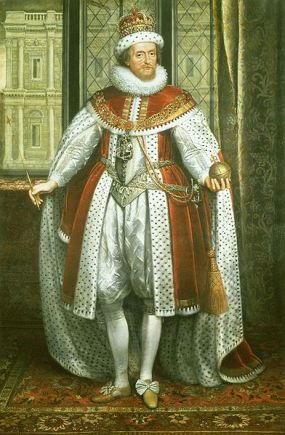 James VI/James I James VI/James I King of Scotland King of England and Ireland (19 June 1566 - 27 March 1625) succeeded Queen Elizabeth I of England on 24 March 1603. Marriage: Princess Anne of Denmark Oldenburg, daughter of King Frederick of Denmark and his wife Sophie of Mecklenburg-Güstrow. James and Anne were married on 23 November 1589 at Oslo, Norway, in a Denmark marriage, and again on 21 January 1590 at Kronberg Castle, Copenhagen. James was the eldest surviving son of Mary, Queen of Scots and only son of Henry Stuart, Lord Darnley. His twin brothers by his mother's third husband were stillborn. As discussed under the descendants of Princess Mary Rose Tudor it was James VI of Scotland, who became King of Scotland on 24 July 1567, who was chosen as the successor of Elizabeth I. Like his mother and grandfather before him, James became regent as a baby. Until the age of sixteen James was under the care of regents. His first regent was his uncle James Stewart, Earl of Moray (1567-1570); second was his grandfather Matthew Stewart, Earl of Lennox (1570-Sep 1571); third was John Erskine, 17th Earl of Mar (Sep 1571-Oct 1572); fourth was James Douglas, 4th Earl of Morton (1572-1578). His marriage to Princess Anne of Denmark produced nine children (two died in childbirth). Only two married and had issue, Elizabeth and Charles who became King Charles I. 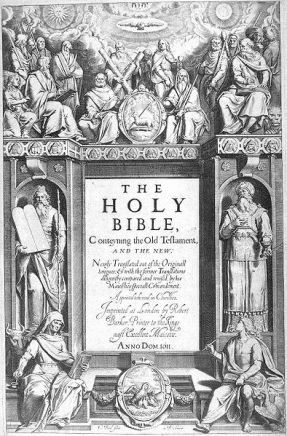 James's political accomplishments (or lack thereof) as King do not concern us here, but suffice it to say that he has had a mixed reception from historians. Most agree that he was a success in Scotland but a partial failure in England. Although James married and had seven children, by nature he was homosexual and the appointment of favourites as advisers caused resentment. James had a Presbyterian background and the Roman Catholic conspirators who attempted to blow up the opening of Parliament on Tuesday 5 November 1605 were suitably dealt with. Robert Cecil and Francis Bacon were among his advisers but he had Sir Walter Raleigh executed for fighting in Spain's American colonies and would not tolerate privateering which had been so profitable in Elizabeth's reign. James's political accomplishments (or lack thereof) as King do not concern us here, but suffice it to say that he has had a mixed reception from historians. Most agree that he was a success in Scotland but a partial failure in England. Although James married and had seven children, by nature he was homosexual and the appointment of favourites as advisers caused resentment. James had a Presbyterian background and the Roman Catholic conspirators who attempted to blow up the opening of Parliament on Tuesday 5 November 1605 were suitably dealt with. Robert Cecil and Francis Bacon were among his advisers but he had Sir Walter Raleigh executed for fighting in Spain's American colonies and would not tolerate privateering which had been so profitable in Elizabeth's reign.James I's impact on English literature is considerable, not least because of his encouragement of and participation in the translation of the Bible into English (1611), the translation that many people still consider the best, and which bears his name, the King James Bible. That, above everything he wrote, is James's monument, but his literary works deserve some credit, and he is always a pleasure to read. |
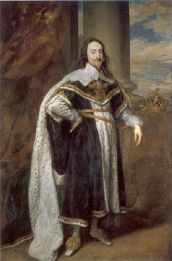 Charles I King of England, Ireland, and Scotland (19 November 1600 - 30 January 1649) Marriage: Henrietta Marie, Princess of France Bourbon. She was the daughter of Henry IV of France and Marie de Medici. The couple had nine children. Only four had issue which included Charles II of England; James II of England; Henrietta Anne, Duchess of Orleans; and Mary Henrietta who would become Princess of Orange - her son William(III) married her niece Queen Mary II of England. Charles' reign saw the beginning of the English Civil War which ended in his beheading and the overthrow on the monarchy in which Oliver Cromwell took over as Lord Protector. England was now refered to as The Commonwealth. In 1660, Parliament voted to restore the monarchy and coincidentally Cromwell ended up getting beheaded himself. *Interesting fact: In London in the front of St. Margaret Church at Westminster is a stone profile of Charles I staring across the road, in front of Parliament, at a monument of Oliver Cromwell. It would be Charles' oldest son, Charles who would become Charles II of England. Charles was buried in the King Henry VIII vault at Windsor Castle. Charles was canonized by the Church of England. He is considered a martyr who died for the preservation of Apostolic Succession in the Anglican Church. | 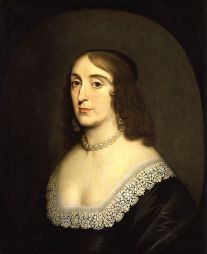 Elizabeth of England Princess of England Queen consort of Bohemia (19 August 1596 - 13 February 1662) Marriage: Frederick V, Elector of Palatine, King of Bohemia Frederick was the son of Frederick IV of Palatine and Countess Louise Juliana of Nassau. The couple had thirteen children; four died young, five would marry, but only four would have issue. Elizabeth was named in honour of Queen Elizabeth. Part of the intent of the Gunpowder Plot of 1605 was to kidnap the nine-year-old Elizabeth and put her on the throne of England (and , presumably, Ireland and Scotland) as a Catholic monarch, after assassinating her father and Protestant English aristocracy. However, this never as Guy Fawkes was caught by the King's soldiers before he was able to ignite the powder. Her husband Frederick was the leader of the Protestant Union and in 1619, as Protestants of the land rebelled against the rule of Ferdinand II, the Holy Roman Emperor, the Bohemian people offered him the crown. Their coronation was on 4 November 1619 and their reign was short lived (26 August 1619 - 8 November 1620) giving him the nickname of 'the Winter King'. As of 1620, Elizabeth also went by the nick-name of 'the Winter Queen' due to her husband's short reign in Bohemia. Her daughter (continued after Queen Anne and Queen Mary), Princess Sophie would become heiress to the throne after an Act of Settlement was declared in her favour. |
| Charles II King of England, Scotland, and Ireland (29 May 1630 - 6 February 1685) Marriage: Catherine of Braganza, Princess of Portugal Born Prince Charles, Duke of Rothesay and Cornwall. Charles' appearance was anything but English, with his sensuous curling mouth, dark complexion, black hair and dark brown eyes, he much resembled his Italian maternal grandmother, Marie de Medici's side of the family. During his escape after the Battle of Worcester, he was referred to as 'a tall, black man' in parliamentary wanted posters. One of the nick-names he acquired was the black boy His height, at six feet two inches, probably inherited from his Danish paternal grandmother, Anne of Denmark, also set him apart from his contemporaries in a time when the average Englishman was far smaller than today. Was restored to the crown after the abolishment of the monarchy by Oliver Cromwell ceased. On 4 April 1660, Charles II issued the Declaration of Breda, in which he made several promises in relation to the reclamation of the crown of England. Monck organized the Convention Parliament, which met for the first time on 25 April. On 8 May it proclaimed that King Charles II had been the lawful monarch since the execution of Charles I on 30 January 1649. "[C]onstitutionally, it was as if the last nineteen years had never happened". Charles returned from exile, leaving The Hague on 23 May and landing at Dover on 25 May. He entered London on 29 May, his birthday. To celebrate "his Majesty's Return to his Parliament", 29 May was made a public holiday, popularly known as Oak Apple Day. He was crowned at Westminster Abbey on 23 April 1661. Charles had a great interest in science, liked to conduct experiments in his laboratory and adored the theatre. 1662 saw the founding of the Royal Society, Charles was its official founder and John Evelyn and Robert Boyle were among its first members. The great scientist, Sir Isaac Newton lived in his reign, as did Hooke, inventor of the microscope, the famous architect, Sir Christopher Wren, the diarist Samuel Pepys and the poet Dryden. It was Charles' reign that saw the 'Great Fire of London' in 1666. The Great Fire of London began before dawn on Sunday, 2nd September, and raged for four days, in the course of which the historic Medieval city known to Chaucer and to Shakespeare vanished. There was no efficient fire fighting force or methods in seventeenth century London. On the morning of the Tuesday, while Cheapside blazed, the king and his brother, James, Duke of York, came down from Whitehall to see the fire for themselves, doing what they could to help -- knocking down buildings to prevent the fire from spreading. By Thursday, the 6th, the fire finally started to die down. Over thirteen thousand houses had been destroyed, the Guildhall, the exchange, 87 churches, taverns and shops. The amount of lives lost could not be tallied. But because of Charles II, a healthier cleaner London arose from its ashes. Charles II ordered an immediate survey of the damage and appointed Sir Christopher Wren as the principal architect for rebuilding the city, who designed the new St. Paul's Cathedral. Incredibly, within four years, the city was rebuilt. A monument was also erected which is now a famous tourist attraction. Rumored to have over 20 illegitimate children, but only recognized 12. As he had no legitimate children by Queen Catherine (two were stillborn and the other died young), he was succeeded by his brother, James. Notable descendants from his illegitimate children include Diana of Wales; Sarah Ferguson, Duchess of York; Camilla, Duchess of Cornwall; Hon. Serena, Viscountess Linley and more. | 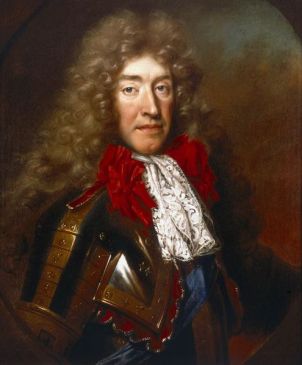 James II/VII King of England and Ireland King of Scotland (14 October 1633 - 16 September 1701) Marriages: 1st: Lady Anne Hyde, Duchess of York, had issue. Out of 8 children, only 2 survived infancy. The future Queen's Mary and Anne. 2nd: Mary of Modena D'Este, had issue. Out of 12 children, only 1 survived, James Francis Stuart, 1st and last Duke of Cornwall. Born Prince James of England and Scotland. A tall man like his elder brother, Charles II, James was described as being 'two yards high', though much fairer complexioned and less foreign looking, he had the flighter colouring of his Danish grandmother. Obstinate and inflexible, James II was not a man to compromise, he completely lacked his brothers endearing sense of humour. Charles II, who knew him well, predicted that after his own demise his brother would soon "go on his travels again" and such proved to be the case. Before he became King he was created Duke of York on 27 January 1644; Earl of Ulster on 10 May 1659; Duc de Normandie [France] on 31 December 1660; 1st Duke of Albany on 31 December 1660 and other misc titles/offices. While still the Duke of York, his first wife, Anne, was drawn to the Catholic faith and converted. The Duke of York also converted to Roman Catholicism in 1668 or 1669, which was kept secret. When his brother, Charles II found out he let it be, but insisted that his daughters, Mary and Anne be raised in the Protestant faith. James' second marriage was to a Catholic Princess of Modena. Many English saw her as an agent of the Pope and viewed her as a threat. On the death of his brother Charles II in 1685, King James II and VII ascended the throne at fifty one years old. Opposition to his rule was widespread, and was lead in the early stages by his main rival, Charles II's unruly and unprincipled illegitimate son, James, Duke of Monmouth. James proceeded to appoint Catholics to positions of power. He was met with staunch opposition when he arrogantly called Parliament to ask for funds to strengthen the army. Opposition to his wishes always infuriated him and he characteristically prorogued Parliament. Heedlessly, he appointed more Catholics to commissions in the army. The army was then posted on Hounslow Heath, a constant and threatening reminder to London and to Parliament of James' strength.He seemed oblivious to the fact that his acceptance was based on the fact that most of his Protestant subjects resigned themselves that James was an ageing man and his daughter and heiress, Mary, was a staunch Protestant who would reverse the changes introduced by her father. His reign sparked the Glorious Revolution where he was disposed of and replaced by his daughter, Mary. Like his brother James also fathered six known illegitimate children by various mistresses. Two by Mistress Catherine Sedley and four by Mistress Arabella Churchill, sister of the 1st Duke of Marlborough. Like his brother, many nobles of the United Kingdom descend from these illegitimate children such as the Earls of Spencer. |
After Queen Anne and the House of Stuart
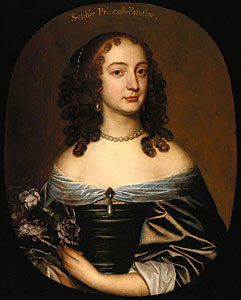 Sophie of Hanover Sophie of HanoverPrincess of the Palatine Electress of Hanover Duchess Sophia of Brunswick-Lüneburg (13 October 1630 - 8 June 1714) Born to Frederick V, Elector Palatine and Princess Elizabeth Stuart in 1630, Sophia grew up in the Dutch Republic, where her family had sought refuge after the sequestration of their Electorate during the Thirty Years' War. On 30 September 1658, Sophia married Ernest Augustus, at Heidelberg, who in 1692 became the first Elector of Brunswick-Lüneburg. Ernst August was a second cousin of Sophia's mother Elizabeth Stuart, as they were both great grandchildren of Christian III of Denmark. Sophie had ten children, but only seven reached adulthood. Her eldest son was George Louis of Hanover, the future King George I of Great Britain. Sophia was made heiress presumptive for the purpose of cutting off any claim by the Catholic James Francis Edward Stuart, who would otherwise have become James III & VIII, as well as denying the throne to many other Catholics and spouses of Catholics who held a claim. The act restricts the British throne to the "Protestant heirs" of Sophia of Hanover who have never been Catholic and who have never married a Catholic. The Act of Settlement of 1701 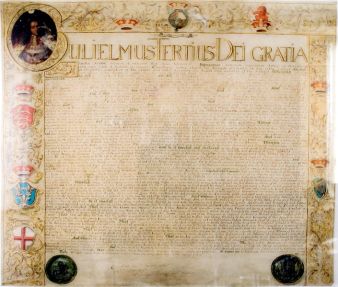 Sophia was declared heir presumptive by the Act of Settlement 1701. Dying before she could become Queen, Sophia passed her claim to the thrones onto her eldest son, George Louis, Elector of Hanover, who ascended them as George I on 1 August 1714 OS. "Therefore for a further Provision of the Succession of the Crown in the Protestant Line We Your Majesties most dutifull and Loyall Subjects the Lords Spirituall and Temporall and Commons in this present Parliament assembled do beseech Your Majesty that it may be enacted and declared and be it enacted and declared by the Kings most Excellent Majesty by and with the Advice and Consent of the Lords Spirituall and Temporall and Commons in this present Parliament assembled and by the Authority of the same That the most Excellent Princess Sophia Electress and Dutchess Dowager of Hannover Daughter of the most Excellent Princess Elizabeth late Queen of Bohemia Daughter of our late Sovereign Lord King James the First of happy Memory be and is hereby declared to be the next in Succession in the Protestant Line to the Imperiall Crown and Dignity of the forsaid Realms of England France and Ireland with the Dominions and Territories thereunto belonging after His Majesty and the Princess Anne of Denmark and in Default of Issue of the said Princess Anne and of His Majesty respectively." 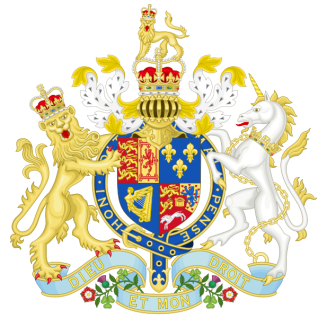 Sophia's Legacy Sophia's LegacyUpon Sophia's death, her eldest son Elector George Louis of Brunswick-Lüneburg (1660–1727) became heir presumptive in her place, and weeks later, succeeded Queen Anne as George I. Sophia's daughter Sophia Charlotte of Hanover (1668-1705) married Frederick I of Prussia, from whom the later Prussian Kings and German Emperors descend. The connection between the German Emperors and the British Royal Family, which was renewed by several marriages in future generations, would become an issue during World War I. The succession was continued as the House of Hanover, then after the marriage of Queen Victoria to Prince Albert of Saxe-Coburg-Gotha the house changed to his until World War I, when the British decided to renounce their German titles to distance themselves from Germany thus deciding to change the name to the House of Windsor. The current Monarch of the United Kingdom, Elizabeth II, as well has her husband, Prince Philip, are direct descendants of George I and therefore Princess Margaret Tudor. Currently, there are more than 5,000 legitimate descendants of Sophia, although not all are in the line of succession to the throne of the United Kingdom. |
| MargaRE Tudor, Queen Dowager and Archibald Douglas, Earl of Angus |
Lady Margaret Douglas Countess of Lennox (18 October 1515 - 7 March 1578) Marriage: Matthew Stuart, 4th Earl of Lennox Daughter of Margaret Tudor and her 2nd husband Archibald Douglas, 6th Earl of Angus Her mother was fleeing from Scotland, seeking shelter with her brother, Henry VIII, when Margaret was born at Harbottle, on the English side of the border. Margaret of Scotland visited England the summer of 1516, bringing her six-month-old daughter, Margaret. Widely reputed to be one of the most beautiful women of her generation, she lived at English Court since 1530, and Henry VIII treated her almost as if she was his own daughter. She was one of Anne Boleyn's ladies. She was in close association with her first cousin, the future Queen Mary I of England, who remained her fast friend throughout life. She was high in the favour of her uncle, King Henry VIII of England, but was twice disgraced; first for an attachment to Lord Thomas Howard, half-uncle of Anne Boleyn, in 1536, who was imprisoned along with Margaret in the Tower of London because of his misalliance with Margaret, where he died in 1537, and again in 1541 for a similar affair with Thomas Howard's half-nephew Charles Howard, the half-brother of Queen Katherine Howard. During Mary's reign, the Countess of Lennox had rooms in Westminster Palace. In November 1553, Queen Mary told the ambassador Simon Renard that Margaret was best suited to succeed her to the throne. On the accession of Queen Elizabeth I, she moved to Yorkshire, where her home at Temple Newsam became a centre for Roman Catholic intrigue. She succeeded in marrying off her son, Henry Stuart, Lord Darnley, to his cousin Mary, Queen of Scots, thus uniting their claims to the English throne. In 1566 she was sent to the Tower of London again, but after the murder of Darnley in 1567 she was released. She denounced Mary I, Queen of Scots, but was eventually reconciled with her daughter-in-law. In 1574 she again aroused Elizabeth I's anger by the marriage of her other son, Charles Stuart, 1st Earl of Lennox, with Elizabeth Cavendish, stepdaughter of the Earl of Shrewsbury. She was sent to the Tower, unlike Lady Shrewsbury, but was pardoned after her son's death in 1576. Margaret's diplomacy largely contributed to the future succession of her grandson, James VI of Scotland, to the English throne. After the death of her son, Charles, she helped care for his daughter, Arbella Stuart. However, she did not outlive him by very long. A few days before her death, she had dined with Robert Dudley, Earl of Leicester, and this led to rumours that she had been poisoned. There is no historical evidence for this. Although she died in debt, she was given a grand funeral in Westminster Abbey, at the expense of Queen Elizabeth I. She was buried in the same grave as her son Charles in the south aisle of Henry VII's chapel in the Abbey. Her grandson James VI of Scotland (who later became James I of England) is said to have erected the fine monument. | 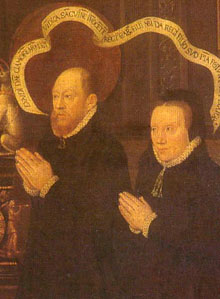 Mathew Stuart 4th Earl of Lennox (21 September 1516, d. 4 September 1571) Married Lady Margaret Douglas on 6 July 1544 at St. James's Palace, St. James's, London. The picture above is part of the painting by Livinus De Vogelaare The memorial of Lord Darnley. The Earl and the Countess of Lennox kneel with his younger son Charles and his grndson James of Scotland, demanding vengeance for Darnley's death in front of his tomb. He was the son of the 3rd Earl of Lennox and Lady Elizabeth Stewart. Matthew's paternal great-grandmother was Princess Mary Stewart of Scotland, daughter of King James II and Mary of Guelders (great-aunt of Anne of Cleves). Matthew's maternal great-grandparents were Joan Beaufort, Queen consort of Scotland and her second husband, Sir James Stewart of Lorn thus making him a descendant of King Edward III of England. During the reign on his grandson, James VI of Scotland/James I of England he was regent from 1570-4 September 1571. Mathew Stuart, was a Scottish nobleman, related to the royal family, being next in the line of succession to the throne after James Hamilton, 2nd Earl of Arran. The early part of his life was passed in the service of the crown of France in the wars of Italy. He took French nationality in 1537, and from this date the French (STUART) spelling of the name derives. Lennox returned to Scotland in 1542, on the death of James V, to contest Arran's claim to be regent for the infant Mary Queen of Scots. In 1544, he allied himself with Henry VIII of England, marrying Margaret Douglas. He lived in England for the next 20 years and led several invasions of Scotland. Lennox and his wife, had several sons, but only two survived, Henry and Charles. They were in great favor in England until the accession of Elizabeth I, who did not trust them. After Elizabeth's accesion, the Lennox became leaders among the Catholic nobility. They succeeded in 1565 marrying their son, Lord Darnley, to Mary Stuart., Queen of Scots. After Darnley's murder, Lennox formally accused the Earl of Bothwell (last husband of Mary Queen of Scots) of the deed but failed to appear at his farcical trial. When Mary was imprisoned, Lennox again became prominent and, through Elizabeth's intervention, was chosen regent to succeed (1570) the 1st Earl of Murray. Mary's party, led by the Hamiltons and William Maitland, at once declared war against him. Lennox was stabbed to death in a raid during this war; killed in an attack on Parliament. His surviving son, Charles, was created Earl of Lennox. |
| Henry Stuart King Consort Henry of Scotland Lord Darnley Duke of Albany (7 December 1545 - 10 February 1567) Marriage: Mary Stuart, Queen of Scotland on 29 Jul 1565, Holyrood Palace, Edinburgh, Scotland. They were father to James I of England (description above) His story is somewhat of a soap opera, for more on him, click <a class="external" href="http://www.luminarium.org/encyclopedia/darnley.htm" rel="nofollow" target="_blank">here</a>. He was created 1st Lord Ardmannoch and 1st Earl of Ross on 15 May 1565. He was educated in England, and his lack of intellectual ability was compensated for by exceptional skill in military exercises. After the death of Francis II of France in 1560 Darnley was sent into that country by his mother, who hoped that he would become King of England on Elizabeth's death, and who already entertained the idea of his marriage with Mary, Queen of Scots, the widow of Francis, as a means to this end. Consequently in 1561 both Lady Margaret and her son, who were English subjects, were imprisoned by Elizabeth; but they were soon released, and Darnley spent some time at the English court before proceeding to Scotland in February 1565. Although Mary had doubtless a short infatuation for Darnley, the union was mainly due to political motives, and in view of the characters of bride and bridegroom it is not surprising that trouble soon arose between them. Contrary to his expectations Darnley did not receive the crown matrimonial, and his foolish and haughty behaviour, his vicious habits, and his boisterous companions did not improve matters. He was on bad terms with the regent Murray and other powerful nobles, who disliked the marriage and were intriguing with Elizabeth. Scotland was filled with rumours of plot and assassination, and civil war was only narrowly avoided. Unable to take any serious part in affairs of state, Darnley soon became estranged from his wife. Darnley was killed in an explosion at Kirk O Field. Much discussion has taken place about the death of Darnley, and the guilt or innocence of Mary is still a question of doubt and debate. It seems highly probable, however, that the Queen was accessory to the murder, which was organized by her lover and third husband, Bothwell. As the father of King James I, Darnley is the direct ancestor of all the sovereigns of England since 1603. Personally he was a very insignificant character and his sole title to fame is his connexion with Mary, Queen of Scots. | Charles Stuart Earl of Lennox (1555 - 1576) In picture: Charles Stuart (L) with brother, Lord Darnley Marriage: Elizabeth Cavendish, daughter of Hon. William Cavendish and Elizabeth "Bess" Harwick. Charles was the second son of Matthew Stewart, 4th Earl of Lennox and of Margaret Douglas. The couple had one daughter, Lady Arabella Stuart. At the time of his father's death in 1571, the earl was acting as regent for the boy king James VI of Scotland (James I of England) and the earldom passed to the Crown. King James's father had been Henry Stuart, Lord Darnley, Charles's elder brother, who was already dead. However, shortly afterwards the title of Earl of Lennox was bestowed on Charles. He proceeded to incur the displeasure of Queen Elizabeth I of England by a hasty marriage to Elizabeth Cavendish, daughter of Bess of Hardwick, apparently at his mother's instigation. The couple had one child, Arabella Stuart, but she was prevented by the Scots from taking up the earldom because of her gender. Arabella Stuart married William Seymour, 2nd Duke of Somerset (great-grandson of Edward Seymour and Anne Stanhope). William Seymour was sixth-in-line, grandson of Lady Catherine Grey, a younger sister of Lady Jane Grey and a granddaughter of Mary Tudor, younger sister of King Henry VIII and Arabella's ancestress, Margaret Tudor. |
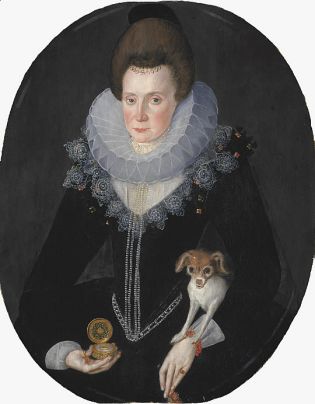 Lady Arabella Stuart Lady Arabella StuartDuchess of Somerset Lady Lennox (1575 - 27 September 1615) Marriage: William Seymour, 2nd Duke of Hertford. William's grandmother was Lady Catherine Grey, granddaughter of Princess Mary Rose Tudor and Charles Brandon, 1st Duke of Suffolk Daughter of Charles Stuart, Earl of Lennox and his wife, Elizabeth Cavendish. Arabella stood in the line of succession to the English throne next to her first cousin James. When Elizabeth's age made a speedy vacancy probable, there were some persons in England who argued that her title was preferable even to that of James, as she was born on English soil, whereas he, being an alien, and therefore disqualified for possessing land in England, was also disqualified for wearing the crown. However, between the end of 1592 and the spring of 1593, the influential Cecils, Elizabeth's Secretaries of State Lord Burghley and his son Sir Robert Cecil turned their attention away from Arabella towards James VI of Scotland, regarding him as a preferable successor. A little before Elizabeth's death Arabella was arrested by the queen's orders in consequence of a rumour that a marriage was planned between her and William Seymour, the grandson of Catherine Grey, the heiress of the Suffolk line. On 2 Feb. 1610, Arabella became actually engaged to William Seymour, whose descent from the Suffolk line made him specially an object of jealousy to James. She and Seymour were summoned before the Privy Council, and declared that he would never marry her without the king's consent. On this Arabella was again taken into favour, and on 22 March received the grant of the Irish monopoly for which she had long been petitioning. Early in July the couple were privately married. The secret was not kept, and on the 9th Arabella was committed to the custody of Sir T. Parry, and her husband to the Tower. Arabella attempted to escape but ended up back in the Tower where she died on 25 September 1615. She and her husband William did not produce any children. Side note: William went on to marry Lady Frances Devereux, daughter of the 2nd Earl of Essex, Elizabeth's favorite after Dudley. Her great-grandmother was Lettice Knollys, granddaughter of Mary Boleyn. Their descendants include many nobles and the current Royal family of the United Kingdom by Queen Elizabeth's mother, Lady Elizabeth Bowes-Lyon, Prince William and Prince Harry also descend through their mother, Lady Diana Spencer. |
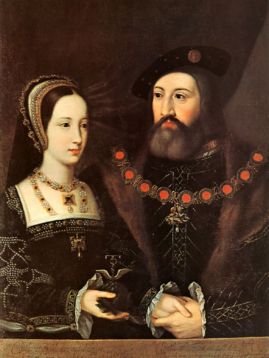 Mary Tudor's Children & Descendants (Henry's younger sister) Born: 18 Mar 1496 Died: 25 Jun 1533 Marriages: 1st: Louis XII of France on 9 Oct 1514, no issue. 2nd: Charles Brandon, 1st Duke of Suffolk on 3 Mar 1515, had issue. |
| Henry Brandon 1st Earl of Lincoln (c. 1523 - 1 March 1534) 2nd son and youngest child of Mary Tudor and Charles Brandon, 1st Duke of Suffolk. His older brother, also named Henry had died in 1522. Brandon was created Earl of Lincoln by Henry VIII on 18 June 1525 at the age of only two. He was "so young that Sir John Vere was appointed to carry him" during the elaborate ceremony. His father planned a marriage for him with Catherine Willoughby (Catherine Brandon in the series), a peeress in her own right and daughter of Maria de Salinas, who had been one of Queen Katherine of Aragon's ladies-in-waiting. |
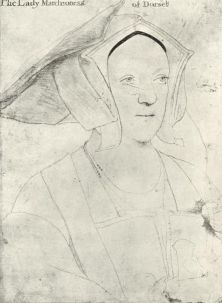 Lady Frances Brandon Duchess of Suffolk 16 July 1517 - 20 November 1559 As eldest daughter of Mary Tudor and by King Henry's will Frances was 1st in line to the English throne after Lady Elizabeth, her cousin from 17 November 1558 – 20 November 1559. Through the third creation of the Duke of Suffolk (who became her husband), she became Duchess of Suffolk. She married again after the execution of her husband to Master of the Horse Adrian Stokes and by him she had three children which all died young. | 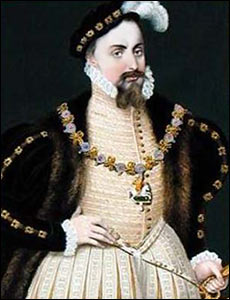 Henry Grey 1st Duke of Suffolk (third creation) 3rd Marquess of Dorset 17 January 1517 - 23 Feb 1554 Son of Thomas Grey, 2nd Marquess of Dorset and Margaret Wotton. He was executed at the Tower of London after his involvement in the conspiracy which resulted in the crowning of his daughter, Jane. |
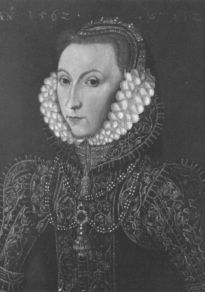 Lady Catherine Grey Countess of Pembroke, Countess of Hertford (25 August 1540 - 26 January 1568) married 1st: Henry Herbert, 2nd Earl of Pembroke, the son of the 1st Earl of Pembroke and Anne Parr, sister of Queen Catherine Parr. The marriage produced no children. 2nd: Sir Edward, 2nd Earl of Hertford Seymour (12 October 1537 – 6 April 1621) Sir Edward was the son of Edward Seymour and Lady Anne Stanhope. Catherine became heir to the throne after her sister was executed. Catherine and Edward were married secretly and without the permission of Queen Elizabeth. When Elizabeth found out the two were imprisoned in the Tower of London. The marriage was annulled and her children declared illegitimate as it was custom to seek the permission of the Queen before marrying and the only witness present at their wedding had died. The couple had two sons:
| Lady Jane Grey Queen of England (1537 - 12 February 1554) married Guildford Dudley (c.1534 - 12 Feb 1554) He was the son of John Dudley, Duke of Northumberland and Jane Guildford. Jane Grey, of course, is also known as 'the Nine Day Queen' as she only reigned for nine days. Jane's was a harsh upbringing, although she recieved an excellent education, having studied Latin, Greek and Hebrew as well as modern languages. Her mother had given birth to a son who died prior to Jane's birth. A contemporary, Baptista Spinola, described Jane as very small but graceful, with hair that was 'nearly red' and brown eyes beneath arched eyebrows. Her skin, he noted, was freckled, and she was thin with small features. Bishop Godwin described her as "handsome, incredibly learned, very quick-witted and wise both beyond her sex and above her age." John Dudley, Duke of Northumberland and Protector during the minority of the young King persuaded the mortally ill Edward to disinherit his sisters, Mary and Elizabeth, declaring both to be bastards. By the terms of Henry VIII's will, the descendants of his older sister Margaret, Queen of Scots, were debarred from the succession to the throne. This left Jane, conveniently married to Northumberland's own son, as the heiress to the throne. After an uprising, backed by her sister, Elizabeth, Mary was declared the rightful Queen of England. Jane, then only sixteen, was arrested and taken to the Tower. She and her husband were executed under Queen Mary's orders. | 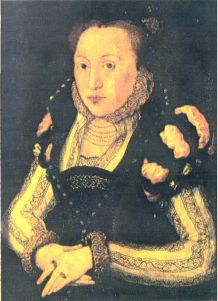 Lady Mary Grey (1545 – 20 April 1578) She was a maid of honor under Queen Elizabeth. All three sisters received a high standard of learning, had the same advantages and all developed differently. In a later age Jane would have been described as the clever sister; Catherine as the pretty, frivolous one; and Mary as that poor little creature for whom nothing could be done: for she was a dwarf, and very ugly. Mary, only a little over four feet tall, with red hair, freckles, and enough of a physical deformity to be nicknamed “Crouchback Mary”. Mary, unfortunately, was hump-backed and a dwarf while Catherine, her sister, was considered the beauty of the family. Like her sister, Catherine, Mary married without the permission of the Queen and was punished for it. She was confined at her household while her husband, Thomas Keyes, was sent to Fleet prison. When Catherine Grey died in 1568, Mary was brought to relative prominence as the last surviving grandchild of Mary Tudor. Since Catherine Grey's children were considered 'illegitimate', some regarded her as heiress presumptive to the English throne. She remained under house arrest until 1572 following the death of Keyes in 1571, and was permitted to attend Court occasionally. Her reported deformity could be described as kyphosis. In spite of the intrigues involving her sisters, it does not appear that Mary Grey ever made a serious claim to the throne. She died childless, aged 33. She was buried at Westminster Abbey under the orders of Queen Elizabeth along side her mother. She has no marker or monument of her own. |
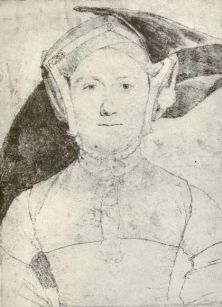 Lady Eleanor Brandon Countess of Cumberland (1519 - 27 September 1547) Youngest daughter of Mary Tudor and Charles Brandon, 1st Duke of Suffolk. In the will of King Henry VIII, he entailed the crown to Eleanor's children if there was no issue from Henry's own children or by his other niece Lady Frances. | 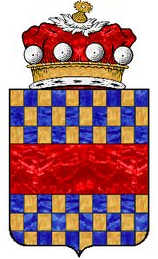 Henry Clifford 2nd Earl of Cumberland (1517 – 6 January 1570) Son of Henry Clifford, 1st Earl of Cumberland and Lady Margaret Percy. The 2nd earl married Eleanor in 1537. The two had one child that survived infancy, Margaret Clifford, Countess of Derby who married the 4th Earl of Derby. After the death of Eleanor in 1547, he remarried to Anne Dacre and had issue by her. |
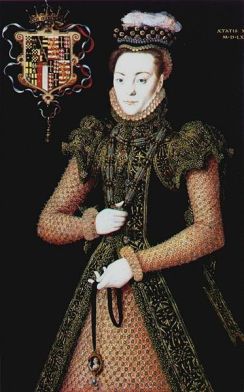 Lady Margaret Clifford Lady Margaret CliffordCountess of Derby (1540 - 28 Sep 1596) married Henry Stanley, 4th Earl of Derby, son of Edward Stanley, 3rd Earl of Derby and Lady Dorothy Howard (daughter of the 2nd Duke of Norfolk and Agnes Tilney), on 7 February 1555 in London. According to the will of Henry VIII, Margaret was in line to inherit the throne of England. Upon the death of her mother she became seventh in line. However, both her cousins Jane Grey and Mary Grey died without issue, and their sister, her other cousin, Catherine Grey, died without the legitimacy of her two sons ever being proven. Margaret quickly moved up to becoming the first in line to the throne, but died prior to the death of Elizabeth I. Margaret and Edward had four children, but only two survived infancy, the 5th and 6th Earls of Derby. |
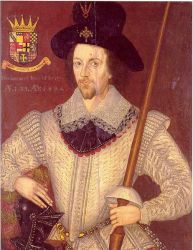 Sir Ferdinando Stanley 5th Earl of Derby (1559 - 16 Apr 1594) According to the will of Henry VIII, his mother was heiress presumptive of Elizabeth I of England from 1578 to her own death in 1596. After her death Ferdinando would have become heir to Elizabeth I, but he predeceased his mother by two years and the queen by nine years. His sudden death led to widespread suspicion of poisoning amid fears of Catholic plots to overthrow Elizabeth. Sir Ferdinando married Alice Spencer, daughter of Sir John Spencer of Althorp and Katherine Kytson c. 1580. The couple had three daughters.
| 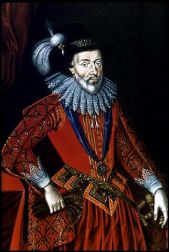 Sir William Stanley 6th Earl of Derby (1561 - 29 Sep 1642) Stanley inherited a prominent social position that was both dangerous and unstable, as his mother was heir to Queen Elizabeth I under the Third Succession Act, a position that fell to his deceased brother's oldest daughter in 1596, shortly after William took the title of Earl. After a period of European travel in his youth, a long legal battle eventually consolidated the Earl's social position, but he was careful to remain circumspect in national politics, devoting himself to administration and cultural projects, including play writing. He married Lady Elizabeth de Vere, daughter of Edward de Vere, 17th Earl of Oxford and Anne Cecil on 26 June 1594. The couple had three children including the 7th Earl of Derby. |
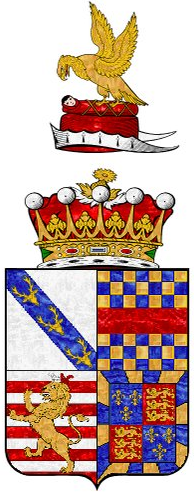 Lady Anne Stanley Lady Anne StanleyCountess of Castlehaven Baroness Chandos of Sudeley (May 1580-Oct 1647) The Coat of arms above is that of Anne's father, Sir Ferdinando showing the Stanley, Clifford, Brandon, and Tudor coat of arms. Lady Anne was the eldest daughter of Sir Ferdinando, 5th Earl of Derby and Alice Spencer. According to the will of Queen Elizabeth's father, Henry VIII, Elizabeth's throne was to pass to the descendants of Henry's younger sister, Mary Tudor, Queen of France, making her the next logical heir. The descendants of Henry's older sister, Margaret Tudor, were bypassed in Henry's will. Senior to Anne Stanley's claim was that of Mary Tudor's granddaughters by her first daughter Lady Frances, Lady Jane Grey, Lady Catherine Grey, and Lady Mary Grey. Lady Jane Grey was England's nine-day Queen and was executed; Lady Catherine Grey, secretly married Edward 1st Earl of Hertford Seymour. The marriage was declared invalid, which made their two sons illegitimate (although the marriage's validity was later reaffirmed by James I). The third of Mary Tudor's granddaughters, Lady Mary Grey, died without issue. Following Lady Mary's death in 1578, Anne Stanley's grandmother, Margaret Clifford, Countess of Derby, assumed the senior position among the descendants of Mary Tudor in terms of inheritance of the rights to the English crown upon the death of her cousin Elizabeth I. Margaret died in 1596 and, her son Ferdinando (father of Anne) having predeceased her, Anne inherited her claims. At the time of Elizabeth's death, however, James VI of Scotland was Elizabeth's closest relative and the great-grandson of Margaret Tudor, Mary Tudor's older sister. As the senior male descendant of Margaret Tudor, he had been favoured as the next successor for several years before Elizabeth's death in 1603. Anne, and the will of Henry VIII, was passed over in favour of James, who became King James I of England Stuart. Lady Anne went on to marry Grey Brydges, 5th Baron Chandos of Sudeley on 28 February 1607, their issue and descendants have been debated to be the rightful King or Queen of England (now the United Kingdom). |
| Lady Frances Stanley Countess of Bridgwater Viscountess Brackley (May 1583 - 1636) Second daughter of Sir Ferdinando Stanley, 5th Earl of Derby and Alice Spencer. Not much is known about Frances' life. She married John Egerton, 1st Earl of Bridgwater who through marriage was step-son to Frances' mother, Alice. The couple had eight children including the 2nd Earl of Bridgwater. The lineage of the Alternate Succession of Mary Tudor - There are no descendants of Lady Anne Stanley recorded living after 1826, although this does not necessarily mean that her line ever went extinct. However, if her line did fail, then her right of succession to the throne of England would have passed to the heirs of her sister Lady Frances Stanley (born 1583). Lady Frances' senior descendant, William Villiers, 10th Earl of Jersey, is said to be the heir to Lady Anne Stanley's claim to the throne of the Kingdom of England. However, it has been pointed out that Lord Jersey's grandfather, George Child Villiers, 9th Earl of Jersey, had been divorced from his first wife before he married Lord Jersey's grandmother. In the opinion of strict legitimists, because Lady Anne and her heirs, the legitimate monarchs, were not in possession of the throne, no English law passed since 1603 is valid. Under the laws of 1603, the 9th Earl of Jersey's divorce was not valid, and therefore his remarriage during his ex-wife's lifetime was null and void, and the children of the marriage ineligible to inherit any claim to the throne. Under a strictly legitimist interpretation, the current holder of the Stanley claim to the throne of England is Lady Caroline Ogilvy, only child of the 9th Earl's first marriage. The heir apparent is her son, Timothy Elliot-Murray-Kynynmound, 7th Earl of Minto, who would hold the claim to the Duchy of Cornwall. |
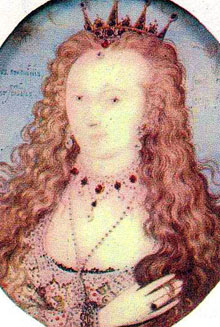 Lady Elizabeth Stanley Lady Elizabeth StanleyCountess of Huntingdon Lady Hastings of Hungerford Lady Botreaux (6 Jan 1588 - 20 Jan 1633) The third and youngest daughter of Sir Ferdinando Stanley, 5th Earl of Derby and Alice Spencer. From 1596, after the death of her grandmother Elizabeth was third in line of the succession to the English throne. On 15 January 1601, shortly after her 13th birthday, Lady Elizabeth married Henry Hastings, the only son of Francis Hastings, Baron Hastings and Lady Sarah Harrington. As his father had died in 1595, Henry was heir to the earldom of Huntingdon. On 31 December 1604, upon the death of his grandfather George Hastings, 4th Earl of Huntingdon, he succeeded as the fifth earl. From that date onward, Lady Elizabeth was styled Countess of Huntingdon, as well as Lady Hastings of Hungerford and Lady Botreaux, since her husband also held those titles. They made their principal home at Ashby de la Zouch Castle, Leicestershire, where the earls of Huntingdon had their family seat. The couple had four children. |
Links:
|
Sources:
|
